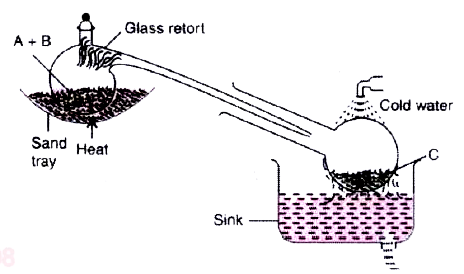Mention the essential material (chemicals) to prepare soap in the laboratory. Describe in brief the test of determining the nature (acidic/alkaline) of the reaction mixture of saponification reaction.
Step-by-Step Text Solution
Step 1: Identify Essential Materials for Soap Preparation
To prepare soap in the laboratory, the following essential materials (chemicals) are required:
1. Oil: This can be any type of vegetable oil (e.g., olive oil, coconut oil, etc.). Oils provide the fatty acids necessary for soap formation.
2. Alkali: Sodium hydroxide (NaOH) is commonly used as the alkali. It reacts with the fatty acids from the oil to produce soap through a process called saponification.
3. Sodium Chloride (NaCl): This is often added to help in the precipitation of soap from the reaction mixture.
Step 2: Describe the Saponification Reaction
The saponification reaction is the process where triglycerides (fats/oils) react with an alkali (like sodium hydroxide) to produce glycerol and soap. The general reaction can be summarized as follows:
Fat/Oil+NaOH→Soap+Glycerol
Step 3: Test for the Nature of the Reaction Mixture
To determine whether the reaction mixture is acidic or alkaline, we can perform a simple test:
1. Observation of Slipperiness: The soap produced is slippery to touch. This is a characteristic property of basic substances.
2. pH Indicator Test: You can use pH indicators like litmus paper or phenolphthalein:
- If you dip blue litmus paper into the solution and it remains blue, or if red litmus paper turns blue, the solution is basic.
- Phenolphthalein will turn pink in a basic solution.
Conclusion: The saponification reaction mixture is alkaline in nature, which is indicated by the slippery feel of soap and the results of the pH test.
---
2. Alkali: Sodium hydroxide (NaOH) is commonly used as the alkali. It reacts with the fatty acids from the oil to produce soap through a process called saponification.
2. pH Indicator Test: You can use pH indicators like litmus paper or phenolphthalein:
- If you dip blue litmus paper into the solution and it remains blue, or if red litmus paper turns blue, the solution is basic.
- Phenolphthalein will turn pink in a basic solution.
Similar Questions
How is nitrogen prepared in the laboratory? Write the chemical equations of the reactions involved.
View SolutionWrite a balanced chemical equation of the reaction involved in the preparation of ethene in the laboratory.
View SolutionHow would you prepare carbon dioxide in the laboratory? Describe its acidic nature and the action on lime water. What is photosynthesis ?
View SolutionState and explain the second law of thermodynamics. Mention the essential conditions for the spontaneity of a chemical reaction.
View SolutionGive reasons for the following - pertaining to the above laboratory preparation of nitric acid
(i) concentrated hydrochloric acid is not used as a reactant in the laboratory preparation
the complete apparatus in the laboratory preparation does not contain parts made of rubber or cork. ,
(iii) the reaction temperature is maintained below 200∘C
(iv) at high temperatures the sodium sulphate or potasium sulphate formed , forms a crust and sticks to the glass apparatus .
View SolutionWrite balanced chemical equation of the reaction for the preparation of nitric acid in the laboratory. What type of change is observed if the reaction mixture is heated above 200∘C?
View SolutionSodium salt of which acid will be needed for the preparation of propane ? Write chemical equation for the reaction.
View SolutionHydrogen chloride gas is prepared in the laboratory using concentrated sulphuric acid and sodium chloride. Answer the question that follow based on this reaction :
Give the balanced chemical equation for the reaction with suitable conditions(s) if any.
View SolutionThe figure given below illustrates the apparatus used in the laboratory preparation of nitric acid.
Write the equation for the reaction in which copper is oxidised by concentrated nitric acid.

View SolutionThe figure given alongside illustrates the apparatus used in the laboratory preparation B of nitric acid.

Write the equation for the reaction in which copper is oxidized by concentrated nitric acid.
View Solution
